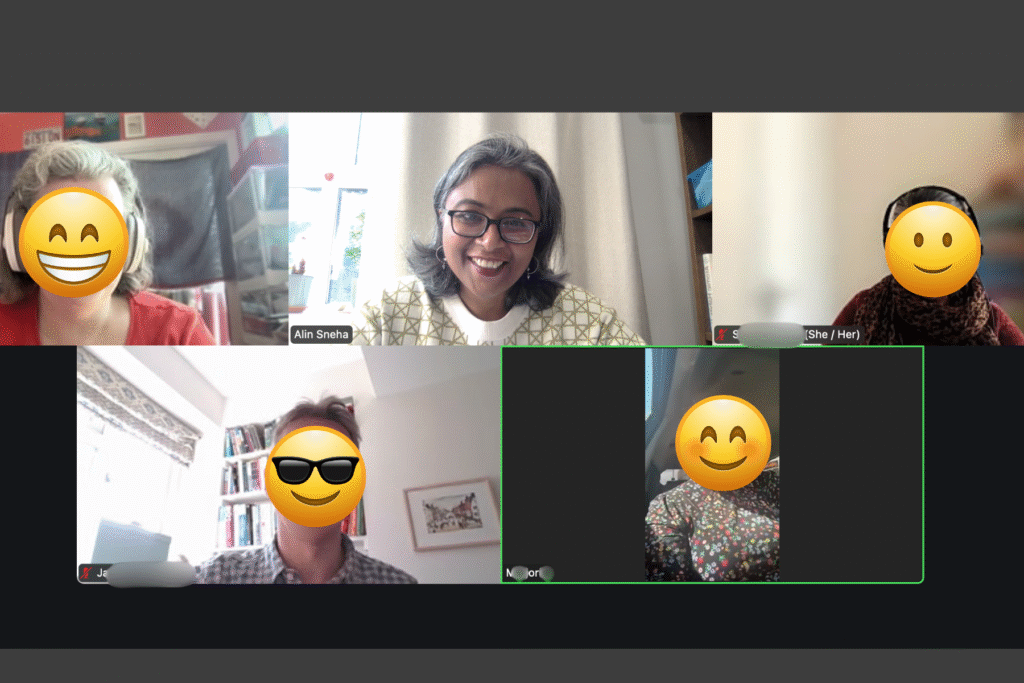Nothing meaningful happens without human connection.
That’s why, as a facilitator, I intentionally invest in:
🔷 Thoughtful Icebreakers or “Openers”
🔷 Warm-up conversations that ease people in
🔷 Establishing trust and emotional safety right from the start
I know that connection can feel even harder to build in virtual meetings — but that is the core job of the person facilitating the meeting.
If we don’t feel connected, we can’t collaborate, and if we can’t collaborate, we won’t achieve the goals we came together for.
Connection is not fluff. It’s a strategic input. Without it, meetings stay surface-level. With it, people feel safe to contribute fully and co-create meaningful outcomes.
That’s why it is vital to focus on trust-building in the first few minutes of every session. Then to establish psychological safety from there.
Tips & Activities to Build Trust in a Meeting
Tips for Trust Building:
- Model openness by sharing something personal or lighthearted first
- Acknowledge contributions, even small ones, so people feel valued
- Encourage equal participation rather than letting one voice dominate
Activities for Trust Building:
🔷 Story Sparks: Pose a light question (e.g., “What’s a small win you had this week?” or “What’s one thing you’re grateful for today?”) and have each person share briefly.
🔷 Common Ground: In pairs or small groups, find 3 non-work things they all share in common within 3 minutes.
🔷 One Word Check-In: Ask everyone to share one word about how they’re arriving to the meeting. It creates presence and humanizes the space. “Hi everyone, I am Alin, and today I am bringing a bit of anxiety and a lot of curiosity in to this meeting”
🔷 Appreciation Round: Invite participants to name one strength they see in the person next to them (works well in teams that know each other).
Tips & Activities to establish Psychological Safety in a meeting:
- Normalize mistakes. Period. Not all mistakes need to be learning opportunities, sometimes mistakes are simply mistakes
- Set clear agreements for respectful communication (no interruptions, assume positive intent)
- Admit when you don’t know something — it models vulnerability
- Explicitly invite quieter voices to contribute without putting them on the spot
- Use inclusive language (“we,” “together,” “let’s explore”) rather than directive commands
Activities for establishing Psychological Safety:
🔷 Working Agreements: Co-create ground rules at the start (e.g., listen actively, build on ideas, step back so others can step in). Build in an element of fun (e.g., Use a safe word if you really need to interrupt someone “Geronimo!”)
🔷 What I Need to be able to Contribute: Invite participants to share one thing that helps them feel comfortable speaking up.
🔷 Permission Slips (inspired by Brené Brown): Ask everyone to write down a permission slip for themselves (e.g., “I give myself permission to ask a ‘silly’ question”). If there is time, go around asking people to read their slips and add your permission seal to it, calling out “Permission Granted”.
🔷 Silent Brainstorm + Share: Give everyone 2–3 minutes to jot ideas silently before open discussion — it levels the playing field for introverts.
✨ Facilitation isn’t just about moving through an agenda. It’s about creating the conditions where people can do their best work — together.
If you’re planning an important meeting and want to make sure connection fuels the conversation, I’d love to help.
👉 Reach out to me to talk about facilitation for your next meeting. Grab a free discovery call slot and let’s talk:

